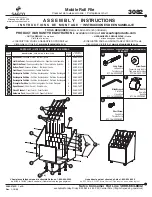
KTR-STOP
®
XS-xx A-xx-xx
Operating/Assembly instructions
KTR-N
Sheet:
Edition:
45126 EN
10 of 22
1
Please observe protection
note ISO 16016.
Drawn:
2020-04-09 Shg/Wie
Replacing:
---
Verified:
2020-08-11 Shg
Replaced by:
•
Repeat this process withthe second half of brake.
Illustration 6
To facilitate the assembly it is possible to fix
the position of the brake by one connection
screw only first. You should preferably insert
the connection screw marked with 1 in illustra-
tion 6. Swing in the brake until the balance of
the screws can be assembled, too (see illustra-
tion 6).
Table 4: Tightening torques of the connection screws
Screw size
Tightening torque T
A
[Nm]
– 10.9
untreated and oiled
Tightening torque T
A
[Nm]
– 10.9
lubricated with MoS
2
M16
302
224
In order to avoid any contact between the brake disk and the brake resulting from thermal
expansion, the distance of the brake as per table 3 needs to be observed.
!
Make sure that the tolerances of the brake disk do not exceed the figures specified in illust-
ration 2.
•
Connect the pressure oil line to one of the pressure ports of the brake (see illustration 7 and 8). For that pur-
pose remove the screw plug beforehand.
!
The hydraulic lines have to be rinsed before connecting to the brake to prevent any partic-
les from penetrating the brake. If the lines are not rinsed sufficiently, the gaskets may be
damaged and the operation of the brake is no longer ensured.
•
Mount a miniature measuring coupling with a miniature measuring hose to the venting hole (see illustration 7
and 8), for that purpose the screw plug needs to be removed beforehand. Discharge the end of the miniature
measuring hose in a suitable collection container.
The pressure ports on top serve for venting the brake. For a wash-up system make use of
one of the pressure ports on top.
Always connect the brake consisting of two halves to a pressure line (see illustration 8),
since the brake disk is loaded with the full braking power on one side in case if one half of
the brake fails.
!
It is not recommended to use steel plugs for venting.
4
Assembly
4.4 Assembly of the brake
4.5 Pressure port of a brake








































